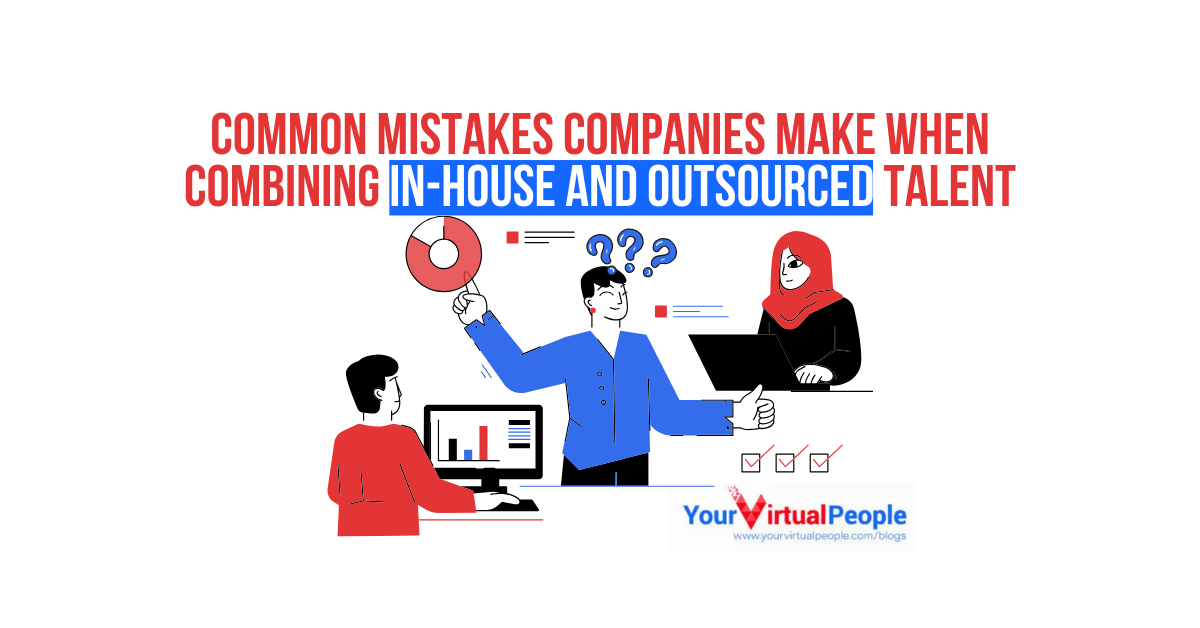So, you’ve decided to mix your in-house dream team with some outsourced talent. Seems like a perfect plan, right? More hands-on deck, fresh ideas, and — best of all — someone else gets to deal with payroll headaches for part of your team. What could possibly go wrong? Well, turns out… quite a bit. Let’s delve into how companies often make common mistakes when attempt combining in-house and outsourced talent. Before you find yourself in a tangled mess of miscommunication, missed deadlines, and awkward Zoom silences, let’s talk about the most common mistakes companies make when combining in-house and outsourced talent. And, of course, how you can avoid them like that email from your boss at 4:59 p.m. on a Friday.
Mistake #1: Treating Outsourced Talent Like Distant Cousins
You know that weird cousin who only shows up to family reunions for free food, then vanishes before helping with the cleanup? That’s exactly how some companies treat their outsourced talent. They assume these folks are just there to do the bare minimum, with no real connection to the rest of the team.
Fix: your outsourced talent shouldn’t feel like guests at the party — they should feel like part of the planning committee. Introduce them to the team, get them on the same communication channels, and make sure everyone’s aligned on goals. Oh, and maybe give them a virtual high five every now and then.
It helps.
Mistake #2: Forgetting That Time Zones Are a Thing
It’s all fun and games until you realize the outsourced developer you hired is 12 hours ahead and just signed off for the day while you’re sipping your morning coffee. Whoops.
Fix: time zones aren’t the enemy — they just require a little planning. Make sure everyone knows when (and when not) to expect communication.
Pro tip: use tools like shared calendars or Slack integrations to keep tabs on who’s online. Just don’t start messaging people at 3 a.m. unless you really want to make them hate you.
Mistake #3: Micromanaging Like It’s Going Out of Style
Some companies think outsourcing is just an excuse to micromanage from a distance. They’ll demand hourly updates, set up daily check-ins, and then wonder why the outsourced team gets irritated and bolts for the door.
Fix: outsourcing doesn’t mean you need to babysit. Set clear expectations from the start, trust your outsourced talent to do what they were hired for, and resist the urge to send, “Just checking in 😊” messages every 30 minutes. They’ve got this — just let them prove it.
Mistake #4: Ignoring Culture Clash
Combining in-house and outsourced talent can feel like merging two very different worlds. Your in-house team has their way of doing things, and your outsourced talent may bring in new processes, tools, or even quirky office habits (like sending emails at midnight with zero explanation).
Fix: instead of forcing everyone to adapt to one RIGHT way of doing things, try to blend both cultures. Keep an open mind to new ideas, and don’t make the mistake of thinking your way is automatically the best. Who knows?
That midnight emailer might just have the key to streamlining your workflow (or they’re just night owls).
Mistake #5: Assuming Everyone Knows “The Plan”
The only thing worse than not having a plan is thinking everyone knows what it is. If your in-house team is working on Version A of a project while your outsourced team is plugging away on Version B… well, you can probably guess how that ends.
Fix: communication is everything.
◼️ Set clear goals
◼️ Deadlines
◼️ Processes
And make sure everyone is on the same page. Share project timelines, documentation, and updates regularly so no one is left guessing. And if there’s any confusion, clear it up before someone spends two weeks working on the wrong thing.
Mistake #6: Forgetting That Outsourced Talent Needs Feedback Too
Outsourced teams aren’t mind readers. If something isn’t working or they’ve veered off course, you need to tell them. Otherwise, you’ll end up with a final product that looks nothing like what you had in mind.
Fix: feedback isn’t just for in-house staff.
Schedule regular review sessions with your outsourced talent and let them know what’s working — and what isn’t. That way, you’ll avoid surprises when it’s too late to make changes.
Mixing in-house and outsourced talent doesn’t have to be a disaster waiting to happen. Sure, there will be challenges, but if you avoid these common mistakes, you can build a team that works like a well-oiled machine (or at least like one that doesn’t crash every other week).
Help is here if you need it, we’ve got your back!
To learn more about our services, visit yourvirtualpeople.com/services/ or book a meeting.



